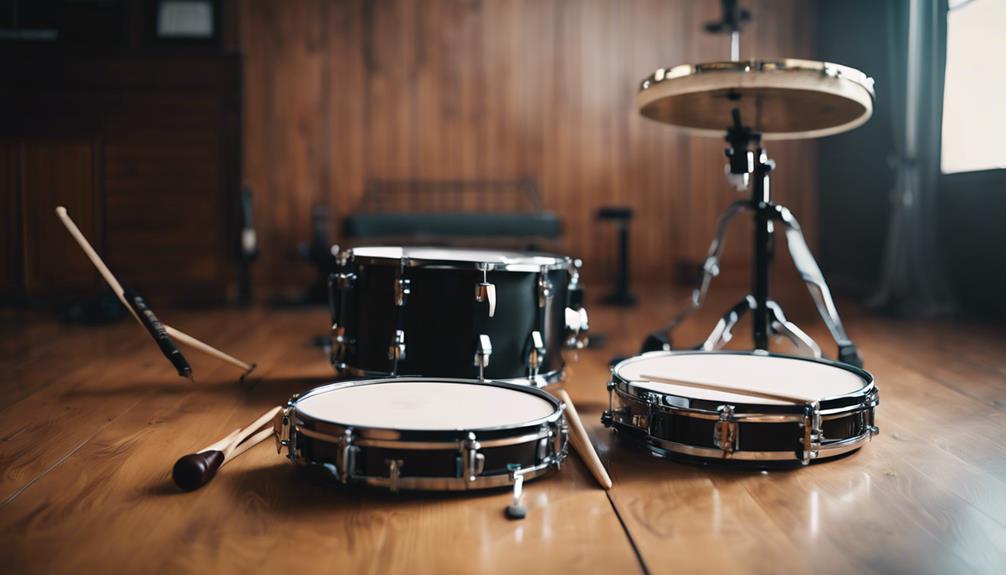When you’re starting out with drum beats, it’s essential to focus on basic patterns that build your coordination and timing. You’ll find that simple rock beats, with their steady bass and snare combo, are perfect for grasping the essentials. As you get comfortable, you’ll explore pop rhythms that highlight snare hits on beats two and four, adding a new layer of complexity. The journey doesn’t stop there; Latin grooves introduce syncopation and clave rhythms, expanding your repertoire even further. Ready to lay down your first beats and discover the secrets to dynamic drumming? Let’s get started.
TL-DR
- Start with mastering basic rock beats at a slow tempo to improve coordination.
- Practice keeping a steady backbeat on the snare drum, focusing on beats two and four.
- Use a drum key to ensure your drum set is properly tuned for better sound.
- Incorporate simple hi-hat patterns to add texture and enhance your groove.
- Focus on precision and consistency to develop a strong foundation in drumming.
Essential Drum Equipment

When starting your drumming journey, you’ll need essential equipment like a drum set, drumsticks, a drum key, a drum throne, and ear protection.
A drum set, especially for rock music, typically includes a snare drum, bass drum, toms, and cymbals. You might opt for a 4-piece or 5-piece configuration based on your budget and preferences. The snare drum is important since it often drives the rhythm in rock music.
Choosing the right drumsticks is important. They’re usually made from hickory or maple and come in various sizes, weights, and tip shapes. For rock music, you’ll likely prefer heavier sticks, like 5A or 5B, for a stronger hit and durability.
A drum key is essential for tuning your drums and adjusting hardware. Proper tuning ensures your drum set sounds its best, which is necessary for playing rock music effectively.
Don’t forget a comfortable drum throne to maintain good posture and play longer without discomfort.
Lastly, ear protection is a necessity. Drumming, especially in rock, can get loud, and protecting your hearing during practice and performances is critical for your long-term health.
Basic Rock Beats
Now that you’ve got your essential equipment, let’s start with mastering basic rock beats, which form the backbone of rock drumming. These beats typically consist of a straightforward pattern: kick drum on beats 1 and 3, and snare drum on beats 2 and 4. For beginners, it’s important to practice these rock beats at a slow tempo initially. This will help you focus on coordination and timing, two critical skills for any drummer.
Adding hi-hat patterns to your rock beats can greatly enhance the groove and depth of your playing. A common hi-hat pattern involves hitting the hi-hat on every eighth note, providing a steady rhythm that complements the kick and snare. Start with simple patterns and gradually experiment with variations as you become more comfortable.
Practicing basic rock beats lays a solid foundation for more complex rhythms and styles. Don’t rush; take your time to make sure each beat is precise and consistent. Additionally, play around with dynamics and accents within your rock beats. This practice will help you develop musical expression and control, making your drumming more interesting and dynamic.
Pop Rhythm Patterns

Pop rhythm patterns often rely on a consistent backbeat on the snare drum to drive the song’s energy. This means you’ll typically hit the snare on beats two and four in a 4/4 time signature, creating a solid and predictable structure. This is the essence of many pop drum beats, providing a reliable foundation for the melody and vocals.
Start by mastering the basic 4/4 time signature pattern. Place your kick drum on beats one and three, and your snare on beats two and four. This simple yet effective pattern is the backbone of countless pop songs. Layer this with steady hi-hat accents, usually played on every eighth note, to add texture and rhythm.
Don’t forget to experiment with hi-hat accents. Changing the dynamics of your hi-hat strikes can add a lot of character to your playing. For example, you can emphasize the “ands” (the off-beats) to create a more syncopated feel.
As you become more comfortable, try incorporating variations with your kick drum. Adding extra kicks on the “ands” can make your drum beats more interesting and dynamic. These subtle changes can make a huge difference, enhancing the groove and keeping the listener engaged.
Latin Groove Techniques
As you’ve mastered pop rhythm patterns, let’s explore the vibrant and intricate world of Latin groove techniques. These techniques are essential for capturing the lively spirit of Latin music. You’ll investigate clave rhythms, syncopation, and polyrhythms, which are the cornerstone of this genre.
To get started, focus on these key elements:
- Clave Rhythms: The heartbeat of Latin music, the clave rhythm guides the timing and feel of the groove. Common patterns include the son clave and the rumba clave.
- Syncopation: Latin grooves often emphasize off-beats, creating a dynamic and unpredictable feel. This technique adds excitement and movement to your drumming.
- Polyrhythms: By layering different rhythms on top of each other, polyrhythms create complex and rich textures. This can involve playing contrasting rhythms with your hands and feet.
Common Latin drum beats like the bossa nova, samba, and mambo each have unique patterns and accents. To truly master these, understanding the cultural context and history behind the music is essential.
Instruments like congas, timbales, and bongos will also enhance your rhythmic complexity and authenticity. Embracing Latin groove techniques will enrich your overall drumming skill set, offering new perspectives on rhythmic diversity and musical expression.
Practice Tips and Resources

To become a proficient drummer, leveraging effective practice tips and resources is essential for honing your skills. Start by utilizing online resources like video tutorials and sheet music to practice drum beats effectively. Video tutorials offer visual demonstrations, making it easier to understand techniques and patterns. Sheet music helps you break down complex drumming patterns into smaller sections, which simplifies learning and mastery.
Focus on building coordination between your hands and feet. This is vital for improving your overall drumming skills. Practicing various exercises will help you achieve this. Additionally, experiment with different tempos and variations. This not only enhances your creativity but also allows for better musical expression in your drum beats.
Setting specific practice goals and tracking your progress can keep you motivated. For instance, aim to master a new beat each week or improve your speed by a certain percentage. Documenting these goals and achievements helps you see tangible improvements over time.
Lastly, don’t forget to enjoy the process. Drumming should be fun and fulfilling, so take breaks when needed and reward yourself for milestones. With the right resources and a structured approach, you’ll find yourself becoming a better drummer each day.
Next up, learn about drum fills for beginners in this guide.
